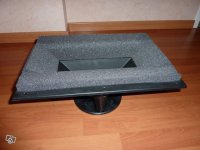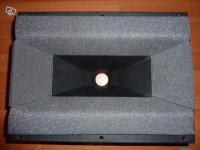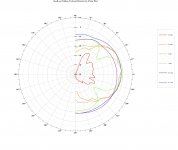I linked it earlier, but yeah, it's basically a beveled open-cell foam designed to act as an edge termination, but since it's only partially absorptive, it's angled to act as a decent termination even if it were a rigid material. It suppressed the peaking of the WG around the cutoff, and made for a nice improvement in smoothness.
It looks very much like what Peavy did with their quadratic waveguides:
Attachments
Scott, I know all about those, It was my waveguide and an older Nathan design. I do not think the Nathans are the right comparison model anyways since the horn is getting too small. 12" Abbey designs should be the minimum for comparing.
When I started discussions over 2 years ago on AVS (first one to have a big thread on that topic there) asking about waveguides the general opinion from almost everyone was to just go buy the Abbey Kits from Geddes because those are the ultimate waveguide designs.
Fast forward to this discussion and Im reading "QSC horns have fewer problems then Geddes OS WG design".
So color me very confused today about all this opinion.
btw, Im not against any QSC recommendation period. I probably bought the most QSCs out of everyone. I think QSC thought I was some pro audio rep or something, some interesting emails from them. As for the XT1464, I still want to build/hear Paul W's raptor design and I still want to try that HUGE IWATA horn from Jzagaga....
When I started discussions over 2 years ago on AVS (first one to have a big thread on that topic there) asking about waveguides the general opinion from almost everyone was to just go buy the Abbey Kits from Geddes because those are the ultimate waveguide designs.
Fast forward to this discussion and Im reading "QSC horns have fewer problems then Geddes OS WG design".
So color me very confused today about all this opinion.
btw, Im not against any QSC recommendation period. I probably bought the most QSCs out of everyone. I think QSC thought I was some pro audio rep or something, some interesting emails from them. As for the XT1464, I still want to build/hear Paul W's raptor design and I still want to try that HUGE IWATA horn from Jzagaga....
Last edited:
Thinking More about Paul W's work I just read this from him on AVS
That would be an awesome new waveguide to get duplicated
Post is here.
Best horn/waveguide for a 1.4" exit CD? - AVS Forum
Agree with your thoughts on the XT vs XR...in fact I'm working on replacing my 80 degree OS WGs with new 32"x26" prolate spheroid WGs, including a gradual increase in directivity with increasing frequency. One of the objectives is to improve on the "splashy" HF sound of constant directivity...achieve a pleasant in-room balance with close to flat response on-axis. Better detail retrieval without sounding bright.
That would be an awesome new waveguide to get duplicated
Post is here.
Best horn/waveguide for a 1.4" exit CD? - AVS Forum
I linked it earlier, but yeah, it's basically a beveled open-cell foam designed to act as an edge termination, but since it's only partially absorptive, it's angled to act as a decent termination even if it were a rigid material. It suppressed the peaking of the WG around the cutoff, and made for a nice improvement in smoothness.
My search isnt helping me find that post. Do you have the link so I can maybe test the same myself?
Because it is only 10" vertical height and yields a respectable +/- 15° or larger (-6 dB) forward vertical lobe when crossed between 1.0 and 1.5 kHz.Zilch those are all great points. OF course, Its the 12" OS WG that I have been discussing so I really do not see how the 14" wide 152i yields anything more practical.
The cost, the aesthetics, and the unresolved vertical polar question.Posting jzagaja's 12" OS waveguide design just had little acceptance and I really wonder why that is.
Read the "Horn vs. Waveguide" thread again; Earl's standard at that time was the predecessor to Abbey, and in some respects, the comparative results were surprising. Duke independently selected the Pyle clone of the original JBL EconoWaveguide for his Prisms after doing considerable research and evaluation of available alternatives. It does not suck, and by one view of Brandon's data, the QSC offers equivalent pattern control performance with the additional benefit of a mouth roundover.I guess I just have never seen those measurements. All measurements of Geddes Abbeys are superior to any QSC design measurements so just what did I miss?Some measurement comparisons would help me understand.
Look, I have no desire to drive Earl out of what is essentially his own thread here -- we have been through this analysis many times over in several forums. We are all navigating the same course with different tool kits, is all, and in my view, with a common purpose, from this larger perspective, merely pals holding each others' feet to the fire....
Last edited:
Scott, I know all about those, It was my waveguide and an older Nathan design. I do not think the Nathans are the right comparison model anyways since the horn is getting too small. 12" Abbey designs should be the minimum for comparing.
..the general opinion from almost everyone was to just go buy the Abbey Kits from Geddes because those are the ultimate waveguide designs.
Fast forward to this discussion and I'm reading "QSC horns have fewer problems then Geddes OS WG design".
So color me very confused today about all this opinion.
Look to the Abby's then!
Abbey
Same basic problems, different results.
..dido for the Suma:
Summa
Opinions do often change over time, particularly with additional information.
..merely pals holding each others' feet to the fire....
..and it's not even much of a "fire".
While it's easy to point out flaws in any particular design, the real question is what is practical for each individual.
I still think that Earl's products fulfill a need at an objective level that isn't being provided from any other source.
Many of your econowave designs have different compromises, but by and large the most determinative difference is that the none of the econowaves are *complete* "kits" (..at least that I'm aware of). In that respect for people wanting everything "sorted-out" in a relatively uncomplicated package - Earl still has his market. And the early expressed sentiment of: "the general opinion from almost everyone was to just go buy the Abbey Kits from Geddes because those are the ultimate waveguide designs", largely remains true.
EconoWave is not a "business," rather, an open-format collaborative, by design affording degrees of freedom for DIYers. In this sense, we are not competitors, and I can make a strong argument that what we do serves in large measure to advance the interests of others selling actual product. Yes, we do offer a PC board implementing a rudimentary version of Wayne Parham's Pi-Speakers crossover topology for $20 a pair, but that's the extent of any economic interest.Many of your econowave designs have different compromises, but by and large the most determinative difference is that the none of the econowaves are *complete* "kits" (..at least that I'm aware of).
During this past year, I have posted a dozen different designs with complete crossover schematics and parts lists, covering a fairly wide spectrum of options:
Flex Your PCD Mettle: - Techtalk Speaker Building, Audio, Video, and Electronics Customer Discussion Forum From Parts-Express.com
World class? Doubtful -- some are decidedly better than others, and you can see us still learning the "ropes" there, but in keeping with the spirit of discovery for which EconoWave is renowned, more specific perspectives defining a process via which others having similar interests might proceed....

Last edited:
Because it is only 10" vertical height and yields a respectable +/- 15° or larger (-6 dB) forward vertical lobe when crossed between 1.0 and 1.5 kHz.
Hello Zilch
Isn't that the same as the Nathan used in the Princeton measurements??
Rob
Attachments
Yes, basically, but the conventional polar plot does not reveal intrusion of the vertical nulls. Look at the directivity map to see that.
Nathan's C/C distance is somewhat wider than is achievable even with the QSC 152i. Frankly, I was surprised to see how low Nathan is crossed to produce a reasonable-height vertical lobe. Earl concedes the Nathan waveguide is too small....
Nathan's C/C distance is somewhat wider than is achievable even with the QSC 152i. Frankly, I was surprised to see how low Nathan is crossed to produce a reasonable-height vertical lobe. Earl concedes the Nathan waveguide is too small....
Last edited:
EconoWave is not a "business," rather, an open-format collaborative, by design affording degrees of freedom for DIYers.
Exactly.
In a broad sense they are direct competitors, but how many DIY'ers are willing to spend 2-4 k on a kit? Alternatively, how many are willing to spend the time necessary to select and then build an econowave version if they could otherwise afford a to spend 2-4k on a kit?
Similar designs, yet very different "markets" (for commercial gain or not).
Fine.
Do it....
Good post
Sorry no can do...I will never own a pair but when/if I get an OS 12" WG would you like one sent to you??
Exactly.
In a broad sense they are direct competitors, but how many DIY'ers are willing to spend 2-4 k on a kit? Alternatively, how many are willing to spend the time necessary to select and then build an econowave version if they could otherwise afford a to spend 2-4k on a kit?
Similar designs, yet very different "markets" (for commercial gain or not).
The direct competition i see is the OS waveguide which is not available vs all types of horns that are avaialble. Nothing else really is all that important to the discussion.
If an 12" OS Waveguide sold for $15 somewhere Im pretty sure there would be a Econo version of it. Considering Zilch has done amazing work already with so many other waveguide choices.
I also think there isnt enough difference for the $4K kit price tag, I remember a waveguide/XO/driver option way back being close to $1K for a pair though, times have changed
Last edited:
Wait for ellipticals and send me a pair of those....I will never own a pair but when/if I get an OS 12" WG would you like one sent to you??
No problem but I have not seen a 12" elliptical OS option anywhere.
XT1464 - Constant Coverage HF Horn
- Home
- Loudspeakers
- Multi-Way
- Geddes on Waveguides


